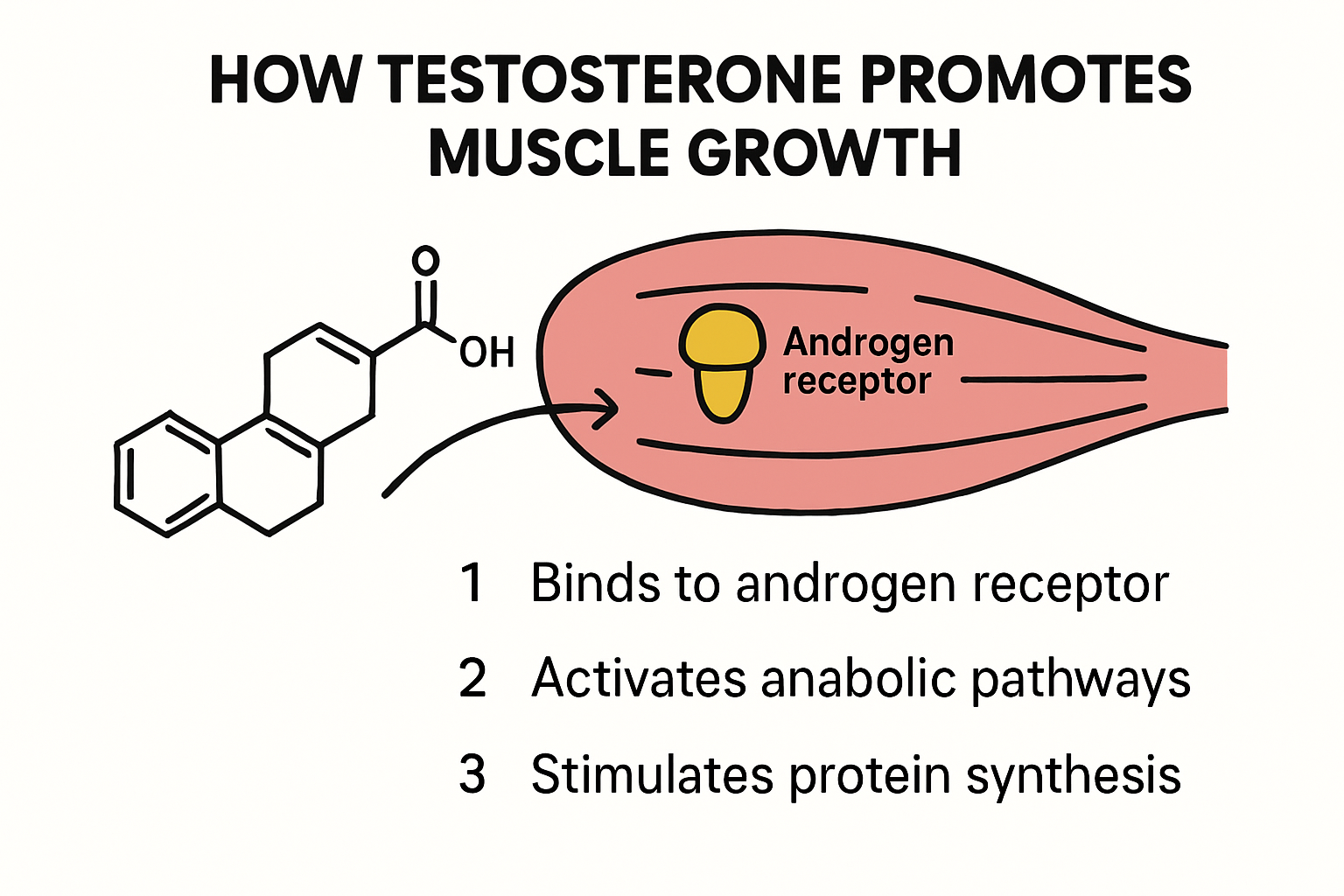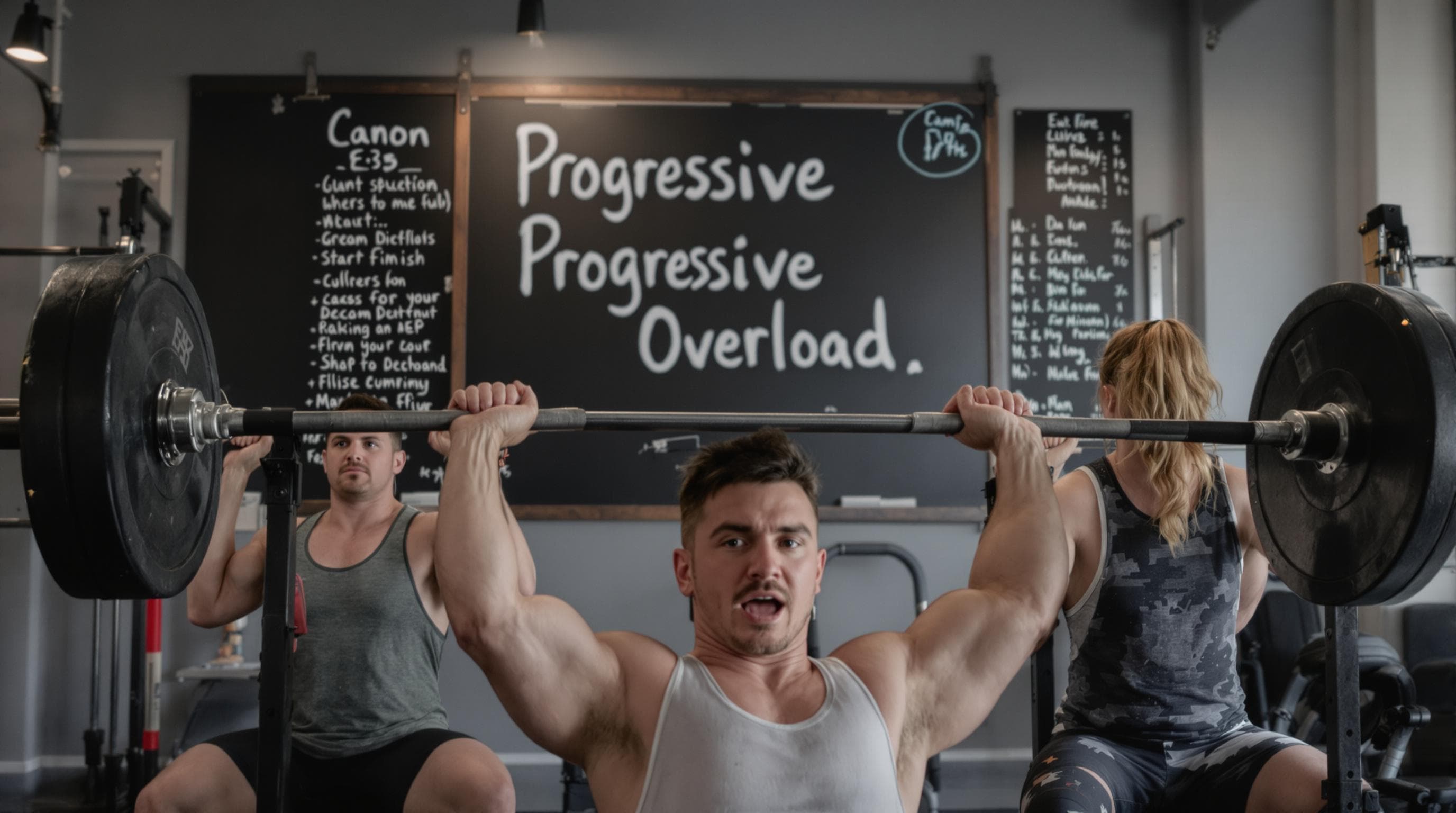Testosterone for Muscle Building: Safe Use Guide 2025
Testosterone has shaped body transformations for decades, with science showing that proper testosterone optimization can boost muscle mass by up to 20 percent in just a few months. Here is the twist. More testosterone does not always mean greater results and can actually backfire if not managed with care. Most lifters miss this entirely, but the safest path to muscle growth involves much more than upping your dose. See how medical oversight, balanced nutrition, and smart training turn testosterone from a risky shortcut into a genuine tool for real gains.
Table of Contents
- How Testosterone Boosts Muscle Growth
- The Molecular Mechanism Of Muscle Growth
- Hormonal Synergy And Muscle Development
- Performance And Recovery Enhancement
- Safe Use Of Testosterone For Muscle Building
- Medical Assessment And Screening
- Dosage And Administration Guidelines
- Monitoring And Potential Side Effects
- Legal And Medical Aspects In The USA
- Regulatory Classification And Legal Considerations
- Medical Prescription And Clinical Guidelines
- Medical Monitoring And Ethical Considerations
- Maximizing Results: Workouts, Diet, And Recovery
- Resistance Training Strategies
- Nutritional Optimization
- Recovery And Hormonal Balance
Quick Summary
| Takeaway | Explanation |
|---|---|
| Testosterone Stimulates Muscle Growth | Testosterone enhances muscle |
hypertrophy by binding to androgen receptors, increasing protein synthesis, and improving recovery from workouts. | | Safe Use Requires Medical Oversight | Testosterone therapy should only be pursued after thorough medical screening, including blood tests to assess hormonal levels and overall health. | | Adhere to Dosage Guidelines | Administration methods like intramuscular injections or transdermal gels should mimic natural testosterone levels to avoid adverse effects. | | Optimize Nutrition for Hormone Levels | A balanced diet with adequate protein and healthy fats, along with key micronutrients like zinc and vitamin D, supports testosterone production. | | Prioritize Recovery for Muscle Growth | Implementing active recovery strategies, sufficient sleep, and stress management is essential for maximizing testosterone levels and promoting muscle repair.
How Testosterone Boosts Muscle Growth
Testosterone plays a critical role in muscle development, acting as a powerful biological catalyst for muscle growth and strength enhancement. Understanding its mechanisms provides insight into why this hormone is so crucial for individuals seeking to build muscle mass and improve physical performance.
The Molecular Mechanism of Muscle Growth
At the cellular level, testosterone triggers muscle hypertrophy through a complex series of biological interactions. Research from the National Institutes of Health reveals that testosterone binds directly to androgen receptors in muscle cells, initiating a cascade of protein synthesis processes. This interaction stimulates protein anabolism, essentially telling muscle cells to grow and repair more efficiently.
The hormone works by increasing nitrogen retention and protein synthesis rates. When testosterone levels are elevated, muscle cells become more responsive to resistance training stimuli. This means muscles can repair and rebuild themselves faster and more effectively after intense workouts. Additionally, testosterone enhances the body's ability to produce muscle-building proteins while simultaneously reducing muscle protein breakdown.

Hormonal Synergy and Muscle Development
Testosterone does not work in isolation. Scientific studies demonstrate that it interacts synergistically with other hormones like growth hormone and insulin-like growth factor-1 (IGF-1). By increasing the release of these anabolic agents and inhibiting certain growth-limiting proteins, testosterone creates an optimal environment for muscle growth.
This hormonal interaction amplifies the body's natural muscle-building processes. Resistance training combined with healthy testosterone levels can significantly accelerate muscle development. The hormone helps recruit more muscle satellite cells, which are crucial for muscle repair and growth. These cells act like biological repair workers, helping muscles recover and become larger and stronger after physical stress.
Performance and Recovery Enhancement
Beyond pure muscle growth, testosterone contributes to overall athletic performance and recovery. It helps reduce muscle damage from intense training, speeds up recovery times, and increases muscle fiber size and strength. Athletes and fitness enthusiasts recognize testosterone's role in not just building muscle, but maintaining muscle quality and supporting long-term physical development.
For individuals interested in understanding more about safe testosterone optimization, our comprehensive guide on muscle building strategies provides additional insights into responsible hormone management.
While testosterone's muscle-building potential is significant, it's crucial to approach hormonal enhancement responsibly. Natural methods like proper nutrition, consistent resistance training, adequate sleep, and stress management can help optimize testosterone levels safely and effectively.
Safe Use of Testosterone for Muscle Building
Safe testosterone use for muscle building requires a comprehensive understanding of potential risks, medical supervision, and responsible administration. Navigating the complex landscape of testosterone enhancement demands careful consideration and professional guidance to maximize benefits while minimizing potential health complications.
Medical Assessment and Screening
Research from the National Institutes of Health indicates that testosterone therapy is not universally appropriate. Before initiating any testosterone regimen, individuals must undergo thorough medical screening. This comprehensive evaluation includes assessing current testosterone levels, overall health status, and potential contraindications.
Medical professionals typically recommend a comprehensive blood panel that examines total and free testosterone levels, complete metabolic profile, lipid panel, and prostate-specific markers. Clinical studies demonstrate that testosterone therapy can be beneficial for individuals with clinically diagnosed hypogonadism, but it is not recommended for healthy individuals seeking performance enhancement.
Dosage and Administration Guidelines
Responsible testosterone use demands precise dosage management. Scientific research reveals that supraphysiologic doses can lead to significant adverse effects. Optimal testosterone supplementation should mimic natural physiological ranges, carefully tailored to individual metabolic profiles.
Medical professionals typically recommend testosterone replacement through controlled methods such as:
- Intramuscular injections: Providing consistent hormone levels
- Transdermal gels: Offering gradual hormone absorption
- Subcutaneous pellets: Ensuring sustained hormone release
For those interested in exploring safe testosterone optimization strategies, consulting with an endocrinology specialist is crucial. These experts can develop personalized protocols that balance muscle-building objectives with overall health considerations.
Monitoring and Potential Side Effects
Continuous medical monitoring is essential during testosterone supplementation. Potential side effects can include cardiovascular strain, liver function alterations, and hormonal imbalances. Regular check-ups enable healthcare providers to adjust treatment protocols and mitigate potential risks.
Key monitoring parameters include:
- Prostate-specific antigen levels
- Cholesterol and triglyceride profiles
- Liver enzyme function
- Hematocrit and red blood cell count
Individuals must approach testosterone use as a medical intervention, not a casual performance enhancement strategy. Natural methods like resistance training, proper nutrition, adequate sleep, and stress management remain fundamental to sustainable muscle development and hormonal health.
Here is a summary table outlining the recommended steps for safe testosterone use, key monitoring protocols, and common side effects to be aware of:
| Step/Protocol | Description |
|---|---|
| Medical Assessment | Blood tests, hormonal evaluation, overall health |
screening | | Prescription & Individualization | Physician prescribes based on clinical diagnosis & personal needs | | Administration Method | Intramuscular injection, transdermal gel, or subcutaneous pellet | | Ongoing Monitoring | Check PSA levels, lipids, liver function, hematocrit/red blood cells | | Watch for Side Effects | Monitor for cardiovascular, liver, and hormonal changes | | Regular Follow-Ups | Periodic reviews and therapy adjustments with healthcare provider |
Legal and Medical Aspects in the USA
Navigating the legal and medical landscape of testosterone use in the United States requires a comprehensive understanding of federal regulations, medical guidelines, and potential legal implications. The complex framework surrounding testosterone administration demands careful consideration and strict adherence to established protocols.
Regulatory Classification and Legal Considerations
According to the Controlled Substances Act, testosterone is classified as a Schedule III controlled substance. This classification carries significant legal implications for possession, distribution, and use. Individuals must obtain testosterone only through legitimate medical channels, with a valid prescription from a licensed healthcare provider.
The legal ramifications of unauthorized testosterone use are substantial. Illegal possession or distribution can result in federal penalties, including potential fines and criminal charges. Medical professionals are required to follow strict guidelines when prescribing testosterone, ensuring that it is used exclusively for medically recognized conditions such as diagnosed hypogonadism.
Medical Prescription and Clinical Guidelines
The Endocrine Society's Clinical Practice Guidelines provide comprehensive insights into appropriate testosterone therapy. These guidelines emphasize that testosterone treatment should be reserved for patients with clear clinical indications. Research published in academic journals demonstrates that testosterone therapy can be beneficial for individuals with documented hormonal deficiencies.
Key medical considerations for testosterone prescription include:
- Comprehensive hormonal assessment: Detailed blood work and clinical evaluation
- Documented testosterone deficiency: Confirmed through multiple diagnostic tests
- Health risk evaluation: Screening for potential contraindications
For those seeking detailed information about testosterone optimization, consulting with a board-certified endocrinologist is crucial to ensure legal and medical compliance.
Medical Monitoring and Ethical Considerations
Responsible testosterone use extends beyond legal compliance. Medical professionals must conduct ongoing monitoring to ensure patient safety and treatment efficacy. This includes regular blood tests, comprehensive health screenings, and periodic reassessment of treatment protocols.
Ethical considerations play a significant role in testosterone administration. Healthcare providers must carefully balance potential benefits against risks, considering factors such as:
- Long-term health implications
- Potential side effects
- Individual patient health profiles
- Comprehensive treatment objectives
The medical community emphasizes that testosterone is not a performance-enhancement tool but a legitimate medical treatment for specific hormonal conditions. Patients must approach testosterone therapy as a carefully managed medical intervention, prioritizing health and safety over performance goals.
Individuals considering testosterone use should remain informed about current medical research, legal regulations, and professional medical guidelines. Transparency with healthcare providers and strict adherence to prescribed protocols are essential for safe and legal testosterone management.
To clarify how testosterone is classified and monitored medically and legally in the USA, the table below summarizes key aspects for safe and legal use:
| Category | Legal/Medical Status |
|---|---|
| Regulatory Class | Schedule III controlled substance |
| Legal Access | Only by prescription through licensed provider |
| Medical Indications | Prescribed for diagnosed hypogonadism, not wellbeing |
| Prescription Process | Requires hormonal assessment and clinical diagnosis |
| Monitoring Requirement | Ongoing labs and physician follow-up |
| Unauthorized Use | Subject to legal penalties and federal prosecution |
Maximizing Results: Workouts, Diet, and Recovery
Optimizing testosterone-driven muscle growth requires a holistic approach that integrates strategic workouts, targeted nutrition, and comprehensive recovery protocols. Success in muscle building depends on carefully synchronizing these fundamental elements to create an environment conducive to maximum physiological adaptation.
Resistance Training Strategies
Research from exercise physiology studies reveals that workout design significantly influences testosterone response. High-volume, high-intensity training with shorter rest intervals produces the most substantial hormonal stimulation. Compound movements like squats, deadlifts, and bench presses trigger greater testosterone release compared to isolation exercises.
Key resistance training principles include:
- Progressive overload: Gradually increasing weight and intensity
- Compound movements: Targeting multiple muscle groups simultaneously
- Moderate to high-intensity training: Maintaining 70-85% of maximum effort

Nutritional Optimization
Nutritional research demonstrates that dietary composition plays a critical role in testosterone production. Contrary to popular low-fat diet trends, balanced macronutrient intake is crucial. Dietary fat, particularly from sources like nuts, avocados, and olive oil, supports hormone synthesis.
Nutritional recommendations for testosterone optimization:
- Adequate protein intake: 1.6-2.2 grams per kilogram of body weight
- Healthy fat consumption: 20-30% of total daily calories
- Micronutrient-rich foods: Zinc, vitamin D, and magnesium-rich sources
Supplementation strategies can further enhance muscle development. Creatine monohydrate has been scientifically proven to increase muscle mass and strength in resistance-trained individuals.
Recovery and Hormonal Balance
Recovery is not merely rest but an active process of muscle repair and hormonal recalibration. Quality sleep, stress management, and strategic rest periods are fundamental to maintaining optimal testosterone levels and muscle growth.
Comprehensive recovery protocols include:
- Consistent sleep schedule: 7-9 hours of quality sleep nightly
- Active recovery techniques: Light movement on rest days
- Stress reduction practices: Meditation, deep breathing exercises
Individuals must understand that muscle growth occurs during recovery, not during the workout itself. Overtraining can lead to decreased testosterone production and increased cortisol levels, potentially hindering muscle development.
Balancing workout intensity, nutritional intake, and recovery is an intricate process. Consultation with fitness professionals and periodic assessment of individual response can help fine-tune these strategies for optimal muscle-building results.
Frequently Asked Questions
How does testosterone promote muscle growth?
Testosterone boosts muscle growth by binding to androgen receptors in muscle cells, increasing protein synthesis, and enhancing recovery from workouts. Research indicates that testosterone can lead to muscle mass increases of up to 20% within a few months when optimized correctly.
Is testosterone therapy safe for muscle building?
Testosterone therapy can be safe when conducted under medical supervision and following proper dosage guidelines. It's essential to undergo a medical assessment to determine if testosterone therapy is appropriate and to monitor potential side effects throughout the treatment.
What are the recommended administration methods for testosterone?
Testosterone can be administered through several methods, including intramuscular injections, transdermal gels, and subcutaneous pellets. These methods should be chosen based on individual health profiles and professional medical advice to mimic natural testosterone levels.
What dietary factors support testosterone production for muscle growth?
A balanced diet is crucial for testosterone production. It should include adequate protein (1.6-2.2 grams per kilogram of body weight), healthy fats (20-30% of total daily calories), and key micronutrients like zinc and vitamin D to optimize hormone levels and support muscle development.
Transform Muscle Building with Safer Testosterone Solutions
Are you struggling to balance muscle gains with the safe use of testosterone? Achieving real progress without risking your health or breaking the law is a concern that many gym enthusiasts share. The article uncovered how medical supervision, responsible dosing, and a supportive environment make all the difference. But even when you understand the science behind testosterone, finding trusted, safe products can still feel overwhelming.
Rx Anabolics is dedicated to helping you reach your muscle-building goals the right way. Our team carefully sources only the highest quality supplements and brings you rewards for every purchase. If you are ready to take the next step toward safe and effective muscle growth, visit Rx Anabolics main site now. You can explore solutions designed for your needs and learn more about responsible testosterone optimization in our muscle building guide. Join a community that prioritizes your safety and results. Your best transformation starts with making the right choice today.




Leave a Reply